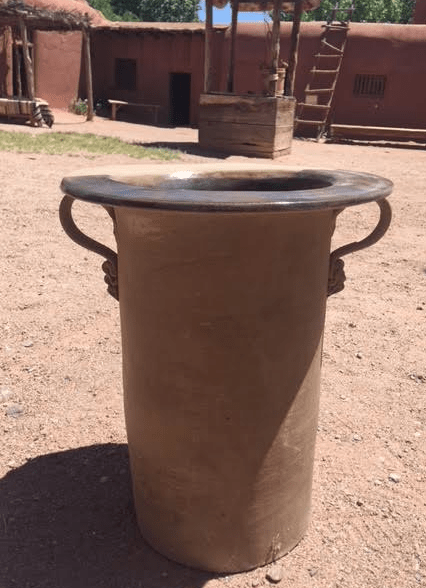Object of the Month
By Amanda Mather
Well, it’s not a pretty subject, but it is one that we all face, day in and day out. So, we wondered, how did Spanish colonists deal with “it?” “It” being the most mundane of tasks: using the bathroom.
In rural and suburban Europe, during the 16th and 17th centuries, many people simply used chamber pots within their homes and then tossed the contents into the street when they filled up. This must have made for some very interesting bobbing and weaving on the streets of Spain, France and Italy. In larger urban areas of Europe, there were more sophisticated means of dealing with human waste. Public toilets were often built near or over rivers in order to carry the waste away. Rudimentary cesspits and fields were built in European cities in order to keep some semblance of hygiene.
When the Spanish arrived here in the New World, and apparently into New Mexico pueblos, in particular, they were astonished by the cleanliness of the place. Pedro de Castañeda, who was on the Coronado expedition, exclaimed upon visiting the pueblos: “The villages are free of nuisances because they go outside to excrete, and they pass their water into clay vessels, which they empty at a distance from the village.”
It appears that the Spanish colonists took notice of this practice and accounts of rural and urban New Mexicans mention emptying their chamber pots (or, as they were called here, “tinajas” or “bacins”) in farmland away from their homes. This practice, especially in rural areas of New Mexico, continued into the late nineteenth century.

A reproduction “tinajas” or “bacins” made by potter Barbara Campbell of El Rito.
Both Native households and Spanish ones found uses for their waste as well, not only as a valuable fertilizer but the uric acid in urine is a great mordant: a dye fixative. Human urine was used to dye wool in New Mexico until the mid-nineteenth century when artificial dyes were introduced.
We have been able to ascertain what these “bacins” looked like in Spanish colonial New Mexico from bits and pieces that have been found in archaeological digs on Spanish colonial households. Several years ago, we had a super talented potter, Barbara Campbell of El Rito, make us several reproduction “bacin” using the archaeological evidence. You will find these way too good looking for what they are intended. These “bacins” are located in the Golondrinas Placita so that our guests can get a first hand look at just how real life worked in Spanish colonial New Mexico.
So, what did folks back then use as toilet paper? Corncobs and juniper bark seem to be the most predominate choices.
Aren’t you glad it’s the 21st Century?
